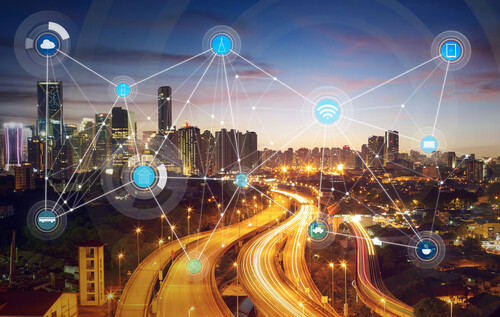Smart cities are gaining popularity across the world thanks to the convenience and efficiency they bring to citizens, visitors, and government leadership. Smart city technology can use data to revolutionize what it means to live and work in a city. First, however, we need the right kind of storage solutions to make all these proposed features functional.
What Kind of Data Do Smart Cities Store?
Smart cities can only function with a potentially huge amount of archived and real-time data, including the following:
- Footage from camera systems: Smart cities may employ cameras to improve public safety, make traffic enforcement and management more efficient, serve as a crime deterrent and build intelligent lighting systems.
- Data from energy distribution systems: Smart grid technology requires data on consumer and commercial energy usage and historical data on troughs and peaks in demand.
- Data from water delivery and sewer systems: Cities increasingly rely on data to automate wastewater treatment plants and plan green wastewater retention sites based on areas with the highest risk of flooding during major storms.
- Data from carbon mapping tools: One U.S. city employed an emerging discipline called “carbon economics” and data gathered at the local level to map out carbon emissions and deploy carbon abatement measures. Some of the measures saved the city as much as $1,200 per ton of CO2
- Data from citywide environmental sensors: Deploying air quality sensors helps cities find and bring action against polluters, place green areas and biomass where air quality is low, and deliver timely and highly accurate air quality alerts to all citizens and visitors.
- Data from smart cars: Cars are becoming more autonomous and more tightly integrated with mobile operating systems. As this trend continues, cars will exchange information with each other and with cities more and more. This transferring of data will reduce congestion, bring more timely interventions during road incidents and help improve rerouting when infrastructure is under repair.
The mission of smart cities is to bring an entirely new level of efficiency to all public services and publicly owned infrastructure, as well as to make sure infrastructure interfaces as cleanly as possible with consumer-level technologies like smart cars, smartphones and wearables. All of these archival and real-time data adds up to enormous storage requirements. The world’s entire datasphere will grow from 33 to 175 zettabytes between 2018 and 2025, according to a Seagate and IDC white paper. By 2025, close to one-third of this information will be real-time data. Expect smart cities to play a vital role in this growth. The question is, how will cities store all the information they need to get smart?
Where Will Smart Cities Store Their Data?
Smart cities can store their data in three main locations:
1. At the Edge
Edge computing happens close to the data’s source. Streaming data in short proximity can be far cheaper than streaming significant quantities of data — such as camera footage — from the source to a storage location and then to relevant departments or authorities. Edge computing provides smart functionality right at the source. AI-powered traffic management is already well under development for smart cities, and it promises to use intelligent automation to detect traffic accidents and congestion and facilitate faster responses to various conditions. This type of computing will happen at the edge of city networks in small data-processing centers. AI-enabled cameras won’t stream everything they capture. Instead, they’ll trigger alerts and prepare the relevant footage for retrieval from on-device storage when they detect an aberrant condition or event.
2. In the Cloud
Some cities will require large quantities of archived data for analytical purposes. This is where centralized cloud repositories come into play. For cloud data systems to be useful and robust, they should use top-quality solid-state drives in their data centers, data redundancy and enterprise-caliber data transmission and encryption. Cloud service solutions typically come with more flexible payment options than building city-owned data centers. City leaders can call upon this type of data when they need to make decisions about things like:
- Infrastructure
- Road construction
- Environmental and air quality remediation
- Building placement
Archival traffic data gathered over weeks and months can help pinpoint the right time to conduct repairs or help civic engineers design traffic flow in new construction projects.
3. In Hybrid Data Storage
Hybrid data storage systems combine the best of both worlds. Sometimes called “IT 4.0”, hybrid data storage allows real-time alerts based on conditions as well as rich stores of data on which new decisions can be built.
What Do Large and Small Cities Need to Know?
Cities with smaller budgets should add smart systems — like smart lighting and traffic management — gradually to portions of the city, starting with edge computing capabilities. Municipalities with larger budgets will probably benefit from the hybrid approach because of its versatility. Edge computing facilitates real-time alerts without the high prices and latency of streaming every byte of data to a server farm. Simultaneously, cloud computing solutions provide the means to retain huge quantities of data over time. Then, engineers, regulators and others can analyze them and make informed decisions. The amount of actual, physical data storage will vary by city and by the size and scope of the proposed systems. One thing that’s not up for debate is data access, however. Cities should work towards the goal of creating open data exchanges using APIs. An application programming interface (API) is a code that allows one smart system to talk to another. Each smart system within a city relies on its own database. Without APIs, these databases won’t be able to exchange information with one another, with other departments or with the public. The Copenhagen City Data Exchange provides a model for cities everywhere for breaking data out of silos and making it available and useful to all parties. Despite involving more than 50 separate IT and similar companies, Copenhagen enjoys high data mobility and lower data management costs for all parties thanks to effective resource sharing. Columbus, Ohio, provides a similar roadmap, as well as a lesson in attracting funding. The U.S. Department of Transportation awarded Columbus a $40 million grant to kick-start several Smart Columbus projects. The city impressed the DoT with its focus on building forward-thinking common interfaces for exchanging data between public and private entities. Cities can fund their smart infrastructure investments in several ways, including public-private partnerships where the government and businesses either share revenue from the resulting services or where the government repays private investments over time after a deferral period. For cities that want to build quickly, the latter model lets them get projects off the ground faster than some of the other cost-sharing models.
Who Are Smart Cities For?
Building any smart city requires communication between all parties about the benefits and savings of smart city technology. It also requires local governments and private interests to remember who these efforts are meant to benefit. If the right data is available, city dwellers could reduce their commutes, see their families breathe easier and even enjoy a more harmonious balance between industry and nature. Data can inform and transform everything in a city if it’s used safely and creatively.











